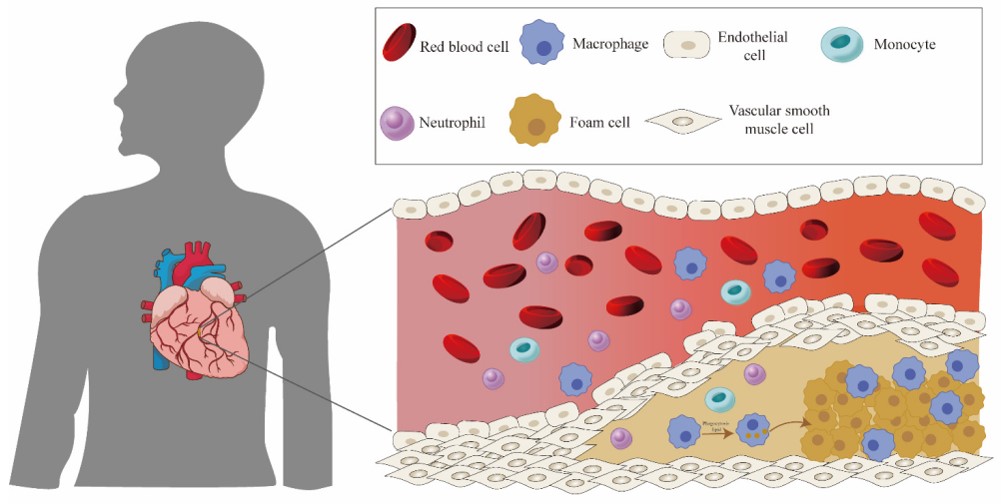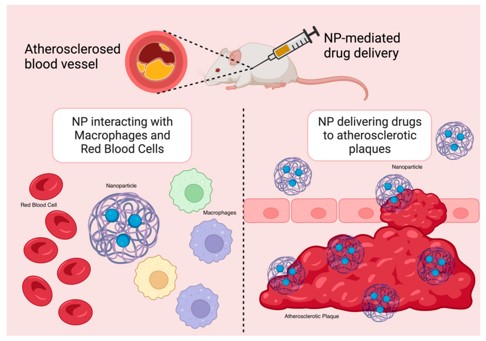Lipid-Based Drug Delivery Systems in Atherosclerosis Treatment
Background Targeted Strategies Our Services
Atherosclerosis (AS) is a systemic, inflammatory vascular disease and is the primary cause of cardiovascular diseases. Traditional treatments often prove inadequate in addressing the multifaceted pathological features of the disease simultaneously. To overcome these challenges, Creative Biolabs has developed advanced lipid-based delivery systems that provide targeted, multifaceted therapeutic approaches aimed at enhancing drug delivery efficiency, reducing systemic side effects, and offering controlled release of therapeutic agents directly to atherosclerotic lesions.
Background of AS Treatment
Atherosclerosis is a disease process driven by inflammatory mediators and lipids. Initially, an excess of lipids accumulates within the arterial walls and oxidizes into oxidized low-density lipoprotein (OxLDL) in the presence of reactive oxygen species (ROS). The oxidative process injures endothelial cells, triggering a series of inflammatory reactions. Sustained inflammation then leads to the accumulation of macrophages, which ingest the oxidized lipids and form foam cells. This sequence of events results in plaque formation, potentially leading to vascular obstruction.
 Fig.1 The process of foam cell formation.1,3
Fig.1 The process of foam cell formation.1,3
Targeted Strategies for AS Treatment
Lipid-based drug delivery systems are nanoscale drug carriers that can enhance the stability and water solubility of drugs, extend circulation time, and thereby improve the safety and efficacy of drugs. To achieve faster and more precise drug delivery and reduce the side effects caused by premature drug release, designing carriers with high specificity and targeting ability has become an important direction for improving AS treatment. Currently, Creative Biolabs can target drug delivery through four strategies: passive targeting, active targeting, biomimetic, and stimuli-responsive strategies.
-
Passive Targeting Strategy: The tight junctions of normal vascular endothelial cells are approximately 2 nanometers, while the gaps in dysfunctional endothelial cells and neovessels within plaques are significantly larger. This phenomenon, similar to the enhanced permeability and retention (EPR) effect seen in solid tumors, lays the foundation for employing passive targeting strategies with nanocarriers in atherosclerosis therapy.
-
Active Targeting Strategy: Modifying lipid-based drug delivery systems with ligands can further enhance their targeting capabilities. In atherosclerosis, the main targets for active targeting include cells (endothelial cells, macrophages, vascular smooth muscle cells) and non-cellular components. Common targets include VCAM-1 and integrins on endothelial cells, and scavenger receptors on macrophages and vascular smooth muscle cells. Non-cellular elements are primarily made up of extracellular matrix constituents like collagen.
-
Biomimetic Strategy: Traditional nanocarriers face many challenges in effectively accumulating in atherosclerotic plaques, such as off-target effects due to the expression of biomarkers in normal tissues and reduced binding efficiency due to limited ligand modification. Nanocarriers engineered through biomimetic strategies mimic natural components, enabling them to evade immune clearance, prolong circulation time, and enhance targeting. Among them, biomimetic strategies based on cell membranes (such as red blood cell membranes, platelet membranes, and white blood cell membranes) and extracellular vesicles are the most common.
-
Stimuli-Responsive Strategy: Lipid-based delivery systems are crafted to respond to endogenous stimuli within the abnormal microenvironment of atherosclerotic lesions, such as low pH, enzymatic activities, and the heightened presence of ROS. Drugs are encapsulated within the carriers through chemical or physical reactions, maintaining structural integrity in normal tissues. Upon reaching the lesion site, the carriers disassemble under specific stimuli and subsequently release the drugs, thereby reducing systemic toxicity associated with small molecule therapies.
 Fig.2 Nanoparticles (NP) targeting atherosclerotic plaques in mouse models.2,3
Fig.2 Nanoparticles (NP) targeting atherosclerotic plaques in mouse models.2,3
How Creative Biolabs Can Help in AS Treatment
-
Targeted Drug Delivery: Our lipid-based delivery systems deliver therapeutic agents directly to atherosclerotic plaques, thereby increasing local drug concentration and diminishing systemic side effects.
-
Inflammation Management: Our systems can reduce inflammation by targeting and modulating inflammatory cells within plaques.
-
Plaque Stabilization: Our systems strengthen plaque stability, thereby lowering the risk of rupture and subsequent cardiovascular events.
-
Lipid Regulation: Our systems can be used to deliver drugs that regulate lipid metabolism, further addressing a key aspect of atherosclerosis.
-
Imaging and Dual-Targeting: We have developed imaging-guided, dual-targeting therapeutic nanoparticles that can be used for both diagnosis and treatment of atherosclerosis, enhancing the precision and efficacy of interventions.
We invite you to explore our ongoing research initiatives to discover how Creative Biolabs is revolutionizing AS therapies through pioneering lipid-based delivery systems. For further information, please contact us.
References
-
Rong, Zhuoyi, et al. "Nano Delivery System for Atherosclerosis." Journal of Functional Biomaterials 16.1 (2024): 2.
-
Pang, Alexander Shao-Rong, et al. "Nanoparticles as Drug Delivery Systems for the Targeted Treatment of Atherosclerosis." Molecules 29.12 (2024): 2873.
-
Distributed under Open Access license CC BY 4.0, without modification.

For Research Use Only. Not For Clinical Use
 Fig.1 The process of foam cell formation.1,3
Fig.1 The process of foam cell formation.1,3
 Fig.2 Nanoparticles (NP) targeting atherosclerotic plaques in mouse models.2,3
Fig.2 Nanoparticles (NP) targeting atherosclerotic plaques in mouse models.2,3
 For Research Use Only. Not For Clinical Use
For Research Use Only. Not For Clinical Use
